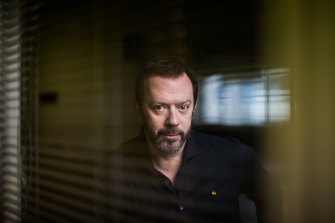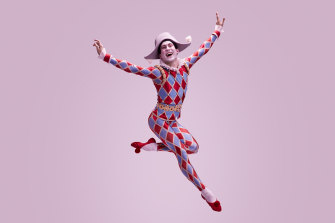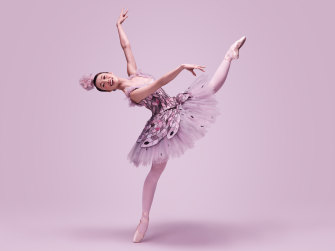
Alexei Ratmansky wears a Ukrainian flag on his chest and says that for him, the situation is “a constant fear”.Credit:Simon Schluter
Alexei Ratmansky is clearly distracted. Sitting in the Australian Ballet’s Southbank studios during a break in rehearsals, the acclaimed choreographer has a lot on his mind. Not only is he in the process of conveying his vision of Harlequinade, the “lost ballet” created in 1900 and resurrected by him in 2018, but his thoughts are with family and fellow artists in Ukraine.
Born in St Petersburg but raised in Kyiv, Ratmansky considers himself Ukrainian: his elderly parents are still in the country, his wife Tatiana is Ukrainian, and Ratmansky was a dancer with the Ukrainian National Ballet from 1986 to 1992, rising to the role of principal. The Russian invasion bites deep.
“It’s painful, it’s a very difficult experience. We communicate every day in hope that everything is going to be all right. So for me it’s a constant fear,” he says quietly. His parents have since moved out of Kyiv to a safer place: but as he points out, nowhere has been safe since the Russians invaded in February.
On the day the invasion began, Ratmansky was in Moscow choreographing a new ballet for the Bolshoi Ballet (where he was artistic director from 2004 to 2008) – he left immediately to return to his adopted home of New York, where he is artist in residence for American Ballet Theater. He says he will not return to Russia until the invasion has ended and those responsible have been tried for war crimes.
“It’s a catastrophe, what happened, in all aspects – cultural, moral, economic, everything,” he says. “It’s a collapse of whole idea.”

Brett Chynoweth as Harlequin in The Australian Ballet’s Harlequinade.Credit:Pierre Toussaint
To say that Ratmansky is in demand as a choreographer is something of an understatement: the 53-year-old has been described by New York Times critic Alasdair Macaulay as “the most gifted choreographer specialising in classical ballet today”. He has made ballets for companies around the world, including the Royal Danish Ballet, the San Francisco Ballet, the Bolshoi and Mariinsky (formerly the Kirov) in Russia, the Royal Swedish Ballet and the Royal Winnipeg Ballet. As renowned dance writer Joan Acocella put it in a 2011 New Yorker profile of Ratmansky: “No one who can afford to call him hasn’t, it seems.”
Australian audiences will remember his Cinderella, which was first staged here in 2013 – a witty, colourful romp of a ballet that pushed the dancers to the limits of their capabilities.
Now he’s back, and again with something mercifully fun in mind: his production of Harlequinade, which he describes as an “archaeology”. What he means is that he wanted to revive a ballet that was originally choreographed 120 years ago by legendary ballet-maker Marius Petipa (who also choreographed some of the world’s most famous ballets, including Swan Lake and The Sleeping Beauty). So he had to do some digging.
He set about exploring the original notation – a written record of the steps the dancers are asked to perform – and piecing together the ballet so that it is as close to Petipa’s 1900 version as possible. And so “we unearth bits and pieces of this lost ballet and we put it together,” he explains.
His is a flying visit to instruct the local dancers in his version of the ballet, which he originally choreographed for American Ballet Theater. While Harlequinade has a love story as its foundation, it is primarily a comedy in the style of commedia dell’arte, an improvised style of theatre popular in Italy in the 16th to 18th centuries. Ratmansky found the notation in archives held at Harvard University – the fact that a 1900 ballet was notated at all was “a miracle” he says, and there was perhaps a second miracle that they have survived.
TAKE 7: THE INSIDE STORY OF HARLEQUINADE
- Created in 1900, Harlequinade disappeared for years following the Russian Revolution.
- The local production will use 70 young dancers from ballet schools around Victoria, one of the largest casts of children in the traditional ballet repertoire.
- Harlequinade is based on the traditions of commedia dell’arte, a witty, abrasive entertainment that burst out of Italy in the mid-1500s.
- The show’s sets and costuming, which were created by Robert Perdziola, were inspired by the original designs held in the collection of a museum in St Petersburg.
- The ballet’s 175 costumes cost an average of $US5000 ($7000).
- The main source of the choreographic text of Harlequinade was a set of notations written out in the Stepanov system, made up of lines, dots, arrows, Xs and Os, across three staves, each corresponding to a different part of the body. After the Revolution the notations were spirited out of the country.
- In 2014, Alexei Ratmansky and his wife Tatiana taught themselves how to read this seemingly impenetrable code with the help of manuals created at the end of the 19th century.
It might be tempting to think that in the 120 years since Harlequinade was originally choreographed, the technique of dancers, and the way ballet itself is performed, would have changed radically. In some ways, this is true, just as a host of other factors in ballet – the flooring, dancers’ bodies and what we know about health and nutrition, staging, technology, even the design of pointe shoes – means dancers can do a range of different steps today that might not have been possible or even thought of in Petipa’s day.
But “I very much disagree with the idea that the technique of the dancers is so much better now,” says Ratmansky. “I think it’s just different.”
Harlequinade centres around the love between young couple Harlequin and Columbine, which looks as though it may be thwarted by Columbine’s rich father – he considers Harlequin too poor to marry his daughter, so he has Columbine locked up by his faithful servant, Pierrot. However, with the help of Pierrot’s wife, who is sympathetic to the couple, and a good fairy who gives Harlequin a magical slap stick, the lovers are united.
I feel more Ukrainian now than ever because I’m proud of this country ... Nothing can be compared to what the Ukrainians are experiencing.
Alexei Ratmansky
Classical ballet more often deals in tragedy than comedy, and Ratmansky says this too, is a challenge: while there is a lot of mime to the audience, he does not want the dancers to slip over into hammy. “You have to have a sense of timing and you have to somehow read the audience’s reaction,” he says. “You shouldn’t oversell it.”
Technically, too, it asks much of dancers: “It’s a challenging thing to do, there are a lot of hops on pointe, the speed of the steps is very different sometimes – it’s quicker than we’re used to now,” he explains. The transitions between the steps are different and there is also a lot of engagement with the audience – again, something rare in classical ballet.
With its bright colours and almost cartoonish sensibility, Harlequinade offers the audience an escape from their modern lives, Ratmansky says. And because the dancers use mime to communicate with the audience throughout the ballet, “the mime is like a secret language that the audience learns as the ballet progresses”.

Ako Kondo as Columbine in Harlequinade.Credit:Pierre Toussaint
“For me what’s important about Harlequinade is that it creates a world on stage. The world is so … different from what’s going on now. The harmony in it, the good humour, the good heart of it, should soothe the pains of today for the audience.”
Ratmansky and Tatiana, who has family in Ivano-Frankivsk in Ukraine’s west, have been glad of the respite of coming to Melbourne to polish Harlequinade. On his all-black outfit, Ratmansky wears a small badge of the blue and yellow Ukrainian flag: the invasion, and the people in danger, are never far from his mind. “I feel more Ukrainian now than ever because I’m proud of this country,” he says. Then he pauses for a second and adds: “It’s a big drama for me, but nothing can be compared to what the Ukrainians are experiencing. It’s on another level completely.”
He has been in touch with many Ukrainian dancers since the war began, even though most of his professional connections are now in Russia. In March he posted on Facebook the devastating news that Artyom Datsishin, a principal dancer with the National Opera House of Ukraine, had died in a Kyiv hospital from injuries he sustained under Russian artillery fire. “He was a beautiful dancer loved by his colleagues,” Ratmansky wrote. “Unbearable pain.”
Now, Ratmansky says, he feels very much part of Ukraine and will do what he can to promote Ukrainian ballet. “Ukraine has to win, but at what price?” he asks. The fact the world is watching this invasion “like a Netflix series”, seeing people being killed every day, seems surreal to him. “It tells me that the whole system is not working, something new has to come out of that.”
He has been somewhat heartened by the widespread support the Ukrainians have had from other countries, and “I hope that this will be the beginning of the world’s reaction on aggression and unjustified wars.” It is constantly occupying his mind. “I was always thinking that we’re so lucky, our lives are luxury,” he says. “But here we go again.”
However, even amid the worry, anger and grief, Ratmansky still finds a place for optimism: “I think after all this ends it’s going to be a renaissance of Ukraine, and I’m very much looking forward to it.”
Harlequinade is at Arts Centre Melbourne, June 17-25. australianballet.com.au
A cultural guide to going out and loving your city. Sign up to our Culture Fix newsletter here.